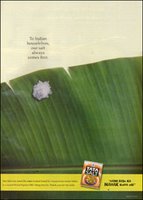Company: Bombay Dyeing
Agency: Orchard /Leo Burnett
Brand Count: 160
Proline is a pioneer in the creation of Sports/ Leisure wear segment in the Indian market. The brand was launched in 1983 by the Batra group was one a premium sought after brand during that time. The Indian apparel market is huge with a market size of Rs 18000-20000 crore.
 There are different versions about the actual size of the branded segment in the apparel market ranging from Rs 2500-4500 crore ( Market size and market share reports are always confusing).
There are different versions about the actual size of the branded segment in the apparel market ranging from Rs 2500-4500 crore ( Market size and market share reports are always confusing).Sports and Leisure wear segment during the eighties were virtually non existent. It would be proper to say that there were no serious effort to brand such apparels. Proline rightfully found the gap. Proline gain prominence in the segment through high profile promotions using sports celebrities. Super players like Ravi Shastri, Sandip Patil, Padukone and other major players from different sports. This created a hugh equity for the brand. Proline was an Aspiration brand for most of the youngsters (middle class) like me during that period. But the brand was premium priced and that kept us from trying out the brand.
Unlike the west, the sports wears are used as casual wears in India. There is little difference between the two segments except for the football jerseys. The consumers used to categories all the Sportswear in the T-shirts category. Proline was successful in projecting a Premium International image in this segment.
Proline buoyed by the success of its brand began retailing initiatives in a big way. The brand was promoted through exclusive shops and " Shop in Shops" in big supermarkets. The owners also began to market international brands like Fila and K-swiss through this retail outlets.
2000 saw the international players entering into Indian market with serious business plans. Brands or icons like Nike , Reebok and Adidas started their brand building efforts. The Pioneer in the market, Proline was dwarfed by the International giants.
Proline could not stand upto the competition from these players . With competition from unbranded players at the bottom of the market together with the onslaught of International brands at the premium end. The brand could not find enough space to fit in.
Proline was positioned as a brand that respect individuality. The brand revolves round the value of " Self Respect" and the confidence gained by accepting what you are. The attitude " Been there
 and Done That" was exemplified by the campaigns. That is one of the best positioning that a brand can opt for.
and Done That" was exemplified by the campaigns. That is one of the best positioning that a brand can opt for.But despite the good brand name, first mover advantage and the memorable positioning, Proline was a brand that could not sustain. The brand is said to have a market share of less than 6% in the segment.
The reason for the underperformace are many :
a. Competition from International players and domestic brand: It is interesting to note that almost all the national brands have a casual sports wear range. Whether it is Colorplus or Peter England, T-shirts are available. That poses serious threat to a pure play sports wear marketer.
b. Value: The brand could not sustain the value proposition in the mind of the consumers. Priced at par with brands like Nike, Proline needed to show the customers more value for the premium it was asking for. More over, there were issues of segmentation. Proline never looked at affordability of the brand. With a choice of international brands, Proline had a tough time convincing the customers to stick to the brand. Further the presence of brands like Fila selling side by side Proline was little risky . Unless the brand is clearly careful about its pricing and segmentation, there is a chance that the franchised brand cannibalise the manufactured brand. I am not sure whether this has happened in Proline's case.
c. Distribution : Proline had limited presence in only major cities.
In 2003, the brand changed hands. Bombay Dyeing took 51 % ownership in the brand and that gave the brand an instant access to the distribution outlet of the textile major. Now Proline also has the responsibility of marketing the failed/failing Vivaldi brand of Bombay Dyeing.
Although brand is now with a textile major, the brand is yet to take off. What the brand Proline needs is some fresh thinking interms of Segmentation. The brand may not be able to compete with the likes of Nike at the premium end. But I feel that there is immense scope for a brand at the affordable segment in the casual wear market. For example , in the t-shirt market, there is a scope for Proline to make a mark if it follows the strategy of Peter England ( quality at affordable price). Although there are brands like Classic Polo, crocodile etc, there still space for Proline.
The brand need not do much to revitalise itself because still Proline commands some respect and recall in the market. Price rationalisation and some high profile brand building will definitely rejuvenate the brand and take it to new heights.
source: businessline, prolineindia.com,agencyfaqs,universalgarment news









